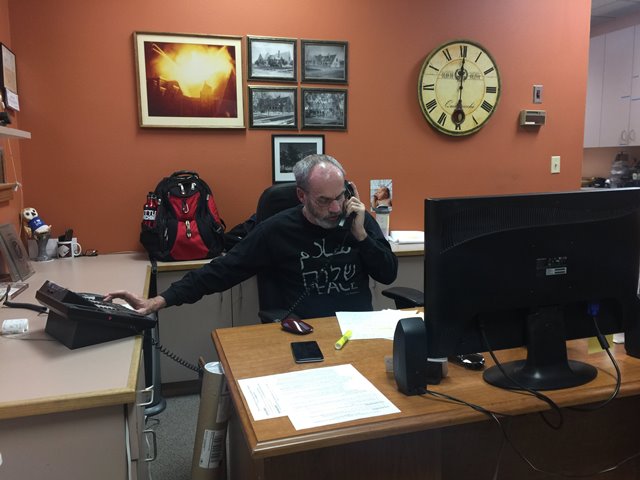In Denver, Jeanette Vizguerra stays in a makeshift bedroom at First Unitarian church, worried that immigration enforcement agents would arrest her elsewhere. In Chicago and Phoenix, the Revs. Emma Lozano and Ken Heintzelman have offered shelter to other undocumented immigrants who think their deportations are imminent.
Since President Trump signed an executive order apparently beefing up immigration law enforcement, stories about undocumented immigrants seeking refuge at churches have emerged.
And the number of US churches willing to offer sanctuary to undocumented immigrants is rising, according to Church World Service.
But what good does seeking shelter at a church do?
Do undocumented immigrants have legal sanctuary at churches?
No, says Stephen Yale-Loehr, who teaches immigration law at Cornell Law School.
Officials with a warrant can arrest undocumented immigrants regardless of whether they’re at a house of worship like a church, synagogue or mosque.
And the Immigration and Nationality Act prohibits anyone from knowingly harboring an undocumented immigrant “in any place, including any building.” Those convicted of doing so risk years in prison.
Then why seek, or provide, refuge at a church?
Being able to arrest an undocumented immigrant at a church is one thing. Doing so is another.
“I think for publicity reasons, immigration enforcement does not like to go into churches,” Yale-Loehr said. So undocumented immigrants fearing imminent deportation feel somewhat safer there.
Indeed, US Immigration and Customs Enforcement has said it generally avoids arrests at “sensitive locations,” including places of worship. The policy doesn’t rule out enforcement there in certain circumstances, such as when a supervisor approves the move, or in instances relating to national security, terrorism or public safety.
ICE says the policy is meant to ensure that people can participate in activities and seek services at sensitive places like churches without hesitation. The policy doesn’t particularly say anything about allowing people to stay at sensitive places full time as a shield against arrest.
In general, prosecutors probably won’t go after a pastor, “though certainly the law permits that,” said Leon Fresco, a former assistant attorney general at the Department of Justice’s Office of Immigration Litigation.
Prosecuting refuge-providing pastors “could end up being more damaging than anything else,” Fresco said.
How many churches are doing it?
The number of churches that are actively offering refuge — and where immigrants are taking them up on it — is unclear. But since Trump was elected in November, the number of churches in the United States expressing willingness to offer sanctuary has doubled to 800, according the Rev. Noel Anderson, national grassroots coordinator at Church World Service.
“The faith community in general, after the election, were looking for ‘what can we do’ to support the immigrant community,” Anderson said. “And the sanctuary movement offered a concrete way for people to respond and show support and solidarity with undocumented people.”
Offering sanctuary at a church can involve providing food and shelter for an immigrant, as well as staffing volunteers to stay with that person around the clock.
So no pastor has been arrested in a case like this?
Well, arrests and charges aren’t plentiful, but they have happened.
In the mid-1980s, for example, the Rev. John Fife of Arizona and other ministers and lay people were arrested on suspicion of harboring undocumented immigrants. They also were accused of helping people enter the country illegally.
Fife and five others were convicted in federal court in 1986 of conspiring to smuggle people into the country, according to a New York Times account; two others were convicted of concealing, harboring or transporting an illegal alien. None served prison time.
The modern US church sanctuary movement is said to have grown out of efforts by Fife and other church leaders in the 1980s to provide sanctuary to Central Americans fleeing violence at home amid reluctance by the federal government to grant them refugee status.
Who else tries to offer sanctuary?
The movement spread beyond churches.
Some leaders have declared their communities as sanctuary cities or counties. There’s no legal definition of a sanctuary city, but such communities generally have policies or laws that limit the extent to which law enforcement and other government employees will go to assist the federal government on immigration matters.
Sanctuary city supporters argue, in part, that undocumented immigrants should be shielded from possible deportation when they report crimes.
Some college students have called for their campuses to become, in effect, sanctuaries for undocumented immigrant students. The University of Pennsylvania is among some US colleges that have said they will not share information about undocumented students with immigration authorities unless required by warrant.
In January, Trump signed an executive action threatening to cut finding to cities that refuse to cooperate with federal immigration officials.
More than 6,000 Americans have signed a pledge through Groundswell, an online social action platform, agreeing to open up their homes, churches, schools, hospitals, college campuses and community centers to immigrants in fear.
